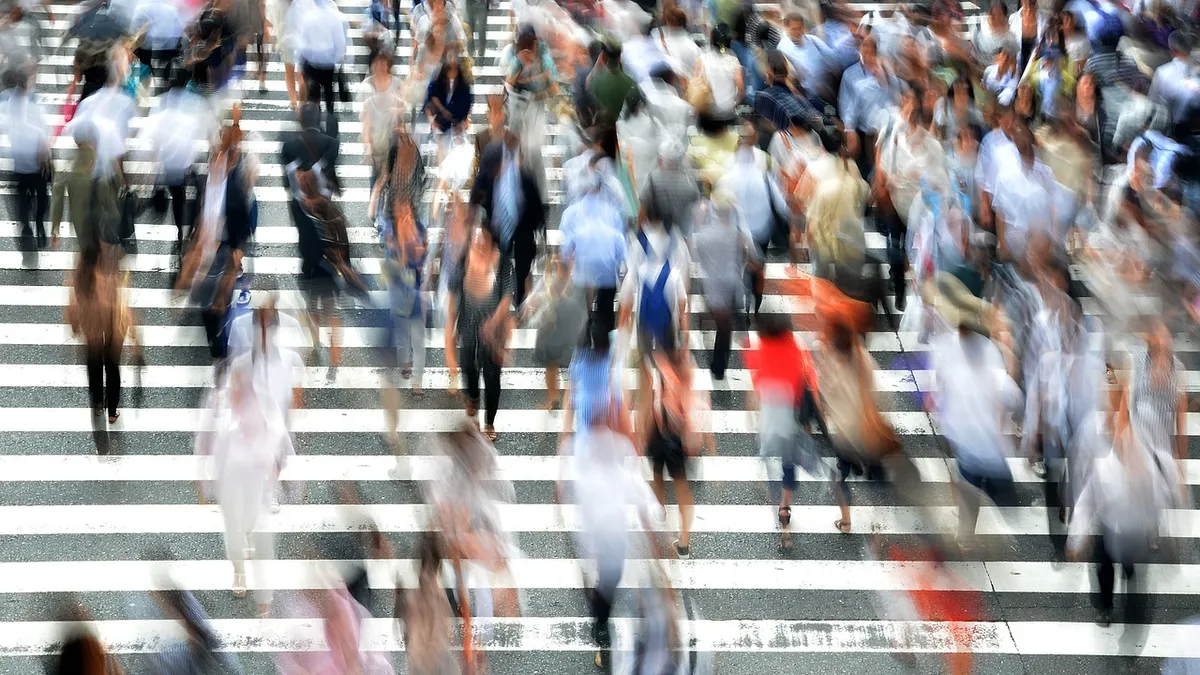Dive Brief:
- U.S. cities are less walkable than their counterparts elsewhere in the world, according to a report from The Institute for Transportation and Development Policy (ITDP).
- ITDP found that while Baltimore, Boston, New York City and San Francisco are among the most walkable cities in the United States, many do not rank highly because of urban sprawl, the continued rise in pedestrian deaths and the lack of mixed-use development that puts amenities closer together and encourages people to leave their cars at home. Street planning, which continues to prioritize how quickly cars can move through, is also a major pain point for walkability, ITDP said.
- Planners must focus on making streets safer and less car-oriented and ITDP released a series of tools with policy recommendations to help them better understand the walkability of their cities and how it can be improved. The tools help planners measure the inclusivity of their public transit systems; how walkable specific neighborhoods are; the walkability of certain streets; and citywide measurements on pedestrian friendliness and safety.
Dive Insight:
The benefits of having more walkable cities are numerous, including reducing emissions and air pollution, as well as helping all residents, especially lower-income ones, reduce their transportation costs, Taylor Reich, a research associate at ITDP and the guide's primary author, said in an interview. Reich also emphasized the mental and physical health benefits of increased walking.
But it has not been easy to achieve walkable neighborhoods in the United States, Reich said, and there are continued concerns over pedestrian safety. While many jurisdictions have emphasized Complete Streets policies to make road use safer for all modes of transportation, pedestrian deaths continue to climb, according to figures collated by the Governors Highway Safety Administration (GHSA).
Efforts to make streets safer for pedestrians require a culture shift in city halls across the country, where planners have for too many years been purely focused on building new roads and trying to make it quicker for cars to get from one point to another, Reich said.
"I think a lot of this is very solidly embedded," Reich said. "It's taught in engineering schools; it's seen as the reference material. City governments are very cautious by nature. A lot of the time, that's very appropriate when it comes to transportation, but I think it really does stand in the way of building sustainable, equitable, resilient communities."
Reich said the new tools have ways to measure walkability at the various levels. The four tools focus on areas like the particulars of street design, the width of sidewalks and driving lanes, vehicle speeds and how easy it is to cross.
But they also assess pedestrian friendliness by looking at available features like benches and trees, which can make a sidewalk space more appealing, and whether areas have amenities close together that can be walked to and from. The proximity of available public transit is also a metric to assess pedestrian friendliness, as it means people can walk to a train or bus rather than drive.
Baltimore, Boston, New York City and San Francisco received praise in the rankings for having 48% of its people near frequent transit and for having a dense population with plenty of amenities and services close by. They also have small city blocks, which ITDP said can make a city more walkable as "pedestrians can choose different routes to get to destinations, letting them combine trips more easily or choose the most pleasant route." The organization called on planners to prioritize smaller block sizes, although it recognized it is a "fundamental characteristic of the city that is slow to change."
There are also lessons to be learned from the rest of the world, Reich said, as they have narrower streets and have been more willing to limit or close some thoroughfares to traffic in a bid to get more people walking. Hong Kong, which has 85% of its residents living near a car-free place, is a leading example of what can be done. The street-closing phenomenon has been increasing in some US cities as they try and encourage socially-distanced exercising and outdoor dining during and after the coronavirus pandemic (COVID-19).
But Reich said it will take a long time to reverse the decades of urban sprawl, which saw planners build large stores on the outskirts of cities and make them only accessible by car, to the detriment of urban destinations.
"We've gotten rid of corner stores, we've gotten rid of neighborhood bakeries and butcher shops and vegetable shops," Reich said. "And we need to bring those back into walkable neighborhoods."
Reich said efforts to make cities more walkable require a multi-faceted effort from planners and city leaders.
"There's no one secret sauce, there's no one thing you can do to make a city walkable," Reich said. "It's many decisions that are made at all levels from individual streets all the way up to the city design."












